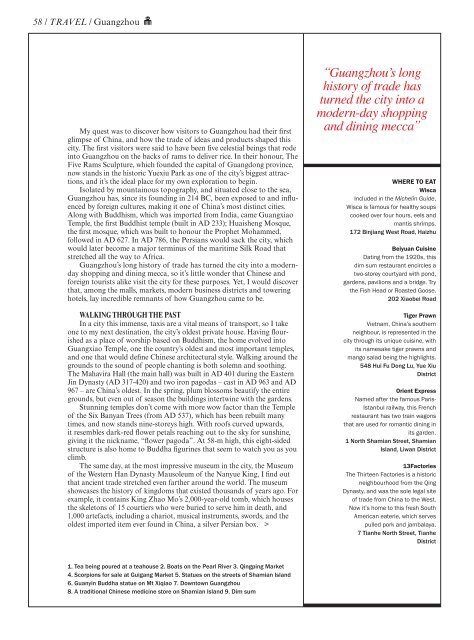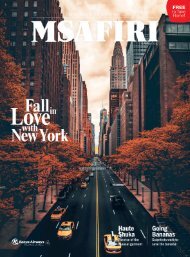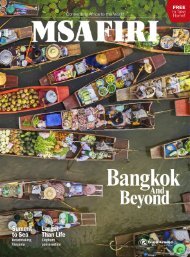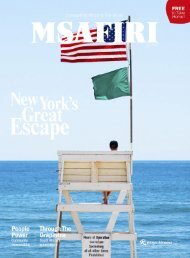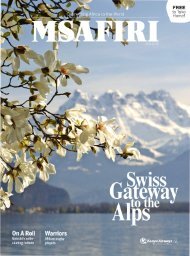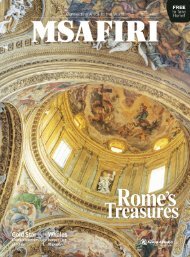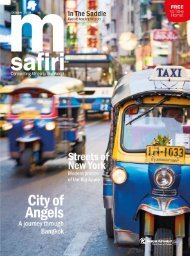You also want an ePaper? Increase the reach of your titles
YUMPU automatically turns print PDFs into web optimized ePapers that Google loves.
58 / TRAVEL / Guangzhou<br />
TRAVEL / 59<br />
My quest was to discover how visitors to Guangzhou had their first<br />
glimpse of China, and how the trade of ideas and products shaped this<br />
city. The first visitors were said to have been five celestial beings that rode<br />
into Guangzhou on the backs of rams to deliver rice. In their honour, The<br />
Five Rams Sculpture, which founded the capital of Guangdong province,<br />
now stands in the historic Yuexiu Park as one of the city’s biggest attractions,<br />
and it’s the ideal place for my own exploration to begin.<br />
Isolated by mountainous topography, and situated close to the sea,<br />
Guangzhou has, since its founding in 214 BC, been exposed to and influenced<br />
by foreign cultures, making it one of China’s most distinct cities.<br />
Along with Buddhism, which was imported from India, came Guangxiao<br />
Temple, the first Buddhist temple (built in AD 233); Huaisheng Mosque,<br />
the first mosque, which was built to honour the Prophet Mohammed,<br />
followed in AD 627. In AD 786, the Persians would sack the city, which<br />
would later become a major terminus of the maritime Silk Road that<br />
stretched all the way to Africa.<br />
Guangzhou’s long history of trade has turned the city into a modernday<br />
shopping and dining mecca, so it’s little wonder that Chinese and<br />
foreign tourists alike visit the city for these purposes. Yet, I would discover<br />
that, among the malls, markets, modern business districts and towering<br />
hotels, lay incredible remnants of how Guangzhou came to be.<br />
“Guangzhou’s long<br />
history of trade has<br />
turned the city into a<br />
modern-day shopping<br />
and dining mecca”<br />
WHERE TO EAT<br />
Wisca<br />
Included in the Michelin Guide,<br />
Wisca is famous for healthy soups<br />
cooked over four hours, eels and<br />
mantis shrimps.<br />
172 Binjiang West Road, Haizhu<br />
Beiyuan Cuisine<br />
Dating from the 1920s, this<br />
dim sum restaurant encircles a<br />
two-storey courtyard with pond,<br />
gardens, pavilions and a bridge. Try<br />
the Fish Head or Roasted Goose.<br />
202 Xiaobei Road<br />
2<br />
WALKING THROUGH THE PAST<br />
In a city this immense, taxis are a vital means of transport, so I take<br />
one to my next destination, the city’s oldest private house. Having flourished<br />
as a place of worship based on Buddhism, the home evolved into<br />
Guangxiao Temple, one the country’s oldest and most important temples,<br />
and one that would define Chinese architectural style. Walking around the<br />
grounds to the sound of people chanting is both solemn and soothing.<br />
The Mahavira Hall (the main hall) was built in AD 401 during the Eastern<br />
Jin Dynasty (AD 317-420) and two iron pagodas – cast in AD 963 and AD<br />
967 – are China’s oldest. In the spring, plum blossoms beautify the entire<br />
grounds, but even out of season the buildings intertwine with the gardens.<br />
Stunning temples don’t come with more wow factor than the Temple<br />
of the Six Banyan Trees (from AD 537), which has been rebuilt many<br />
times, and now stands nine-storeys high. With roofs curved upwards,<br />
it resembles dark-red flower petals reaching out to the sky for sunshine,<br />
giving it the nickname, “flower pagoda”. At 58-m high, this eight-sided<br />
structure is also home to Buddha figurines that seem to watch you as you<br />
climb.<br />
The same day, at the most impressive museum in the city, the Museum<br />
of the Western Han Dynasty Mausoleum of the Nanyue King, I find out<br />
that ancient trade stretched even farther around the world. The museum<br />
showcases the history of kingdoms that existed thousands of years ago. For<br />
example, it contains King Zhao Mo’s 2,000-year-old tomb, which houses<br />
the skeletons of 15 courtiers who were buried to serve him in death, and<br />
1,000 artefacts, including a chariot, musical instruments, swords, and the<br />
oldest imported item ever found in China, a silver Persian box. ><br />
1. Tea being poured at a teahouse 2. Boats on the Pearl River 3. Qingping Market<br />
4. Scorpions for sale at Guigang Market 5. Statues on the streets of Shamian Island<br />
6. Guanyin Buddha statue on Mt Xiqiao 7. Downtown Guangzhou<br />
8. A traditional Chinese medicine store on Shamian Island 9. Dim sum<br />
Tiger Prawn<br />
Vietnam, China’s southern<br />
neighbour, is represented in the<br />
city through its unique cuisine, with<br />
its namesake tiger prawns and<br />
mango salad being the highlights.<br />
548 Hui Fu Dong Lu, Yue Xiu<br />
District<br />
Orient Express<br />
Named after the famous Paris-<br />
Istanbul railway, this French<br />
restaurant has two train wagons<br />
that are used for romantic dining in<br />
its garden.<br />
1 North Shamian Street, Shamian<br />
Island, Liwan District<br />
13Factories<br />
The Thirteen Factories is a historic<br />
neighbourhood from the Qing<br />
Dynasty, and was the sole legal site<br />
of trade from China to the West.<br />
Now it’s home to this fresh South<br />
American eaterie, which serves<br />
pulled pork and jambalaya.<br />
7 Tianhe North Street, Tianhe<br />
District<br />
Sarah Coghill, Robert Michael Poole, Alamy, Shutterstock, Getty Images<br />
1 3 4<br />
8<br />
5<br />
6 7 9


